Incorporating vintage design trends into modern artisan jewelry can significantly elevate its aesthetic and emotional value. By blending historical influences such as Art Deco, Victorian motifs, and Mid-century modern styles with contemporary craftsmanship, artisans can create unique pieces that resonate with buyers. Sourcing vintage materials adds authenticity and character, ensuring each creation tells a story while maintaining durability.
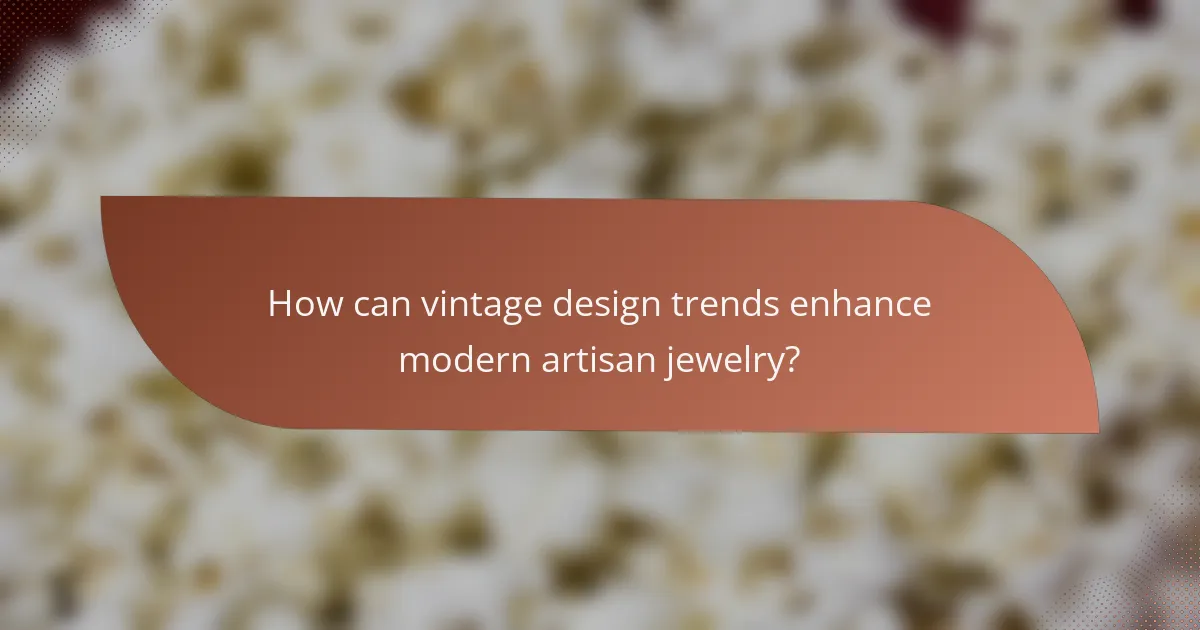
How can vintage design trends enhance modern artisan jewelry?
Incorporating vintage design trends into modern artisan jewelry can significantly elevate its aesthetic and emotional value. These trends bring a sense of history and uniqueness, making contemporary pieces more appealing and meaningful to buyers.
Increased aesthetic appeal
Vintage design trends often feature intricate details, unique patterns, and rich textures that can enhance the visual allure of modern jewelry. For instance, using Art Deco geometric shapes or Victorian floral motifs can create a striking contrast with minimalist designs, attracting a broader audience.
When selecting vintage elements, consider color palettes that resonate with current fashion trends while still paying homage to the past. Combining vintage stones like opals or garnets with modern metals can create a captivating look that stands out in the market.
Unique storytelling elements
Each vintage design element carries its own story, which can add depth to modern artisan jewelry. By incorporating features from specific eras, artisans can create pieces that evoke nostalgia or celebrate particular cultural moments. For example, a necklace inspired by the 1920s can resonate with the spirit of the Jazz Age.
Artisans can enhance the storytelling aspect by providing context for their designs, such as sharing the historical significance of certain motifs or materials. This narrative can engage customers and make the jewelry more memorable.
Timelessness and durability
Vintage design trends often emphasize craftsmanship and quality, which can contribute to the longevity of modern artisan jewelry. By adopting techniques from the past, such as hand engraving or stone setting, artisans can create pieces that withstand the test of time both in style and durability.
When selecting materials, opt for high-quality metals and stones that have proven durability over the years. This not only ensures that the jewelry lasts but also enhances its value, making it a worthwhile investment for customers.
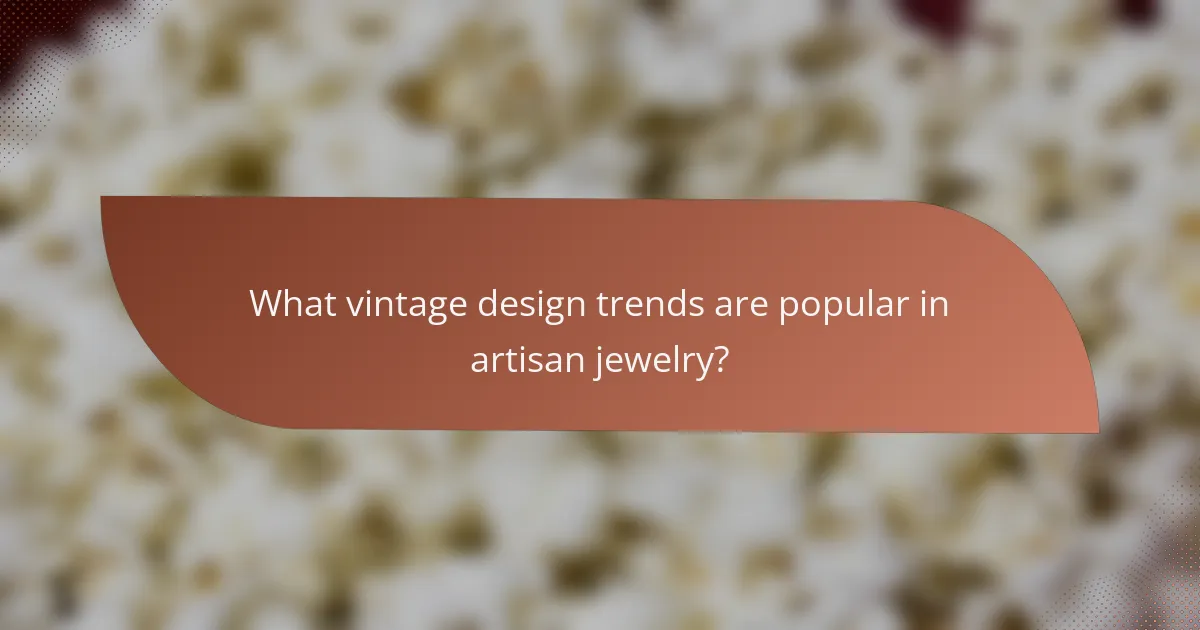
What vintage design trends are popular in artisan jewelry?
Popular vintage design trends in artisan jewelry include Art Deco, Victorian motifs, and Mid-century modern styles. These elements are characterized by distinct aesthetics that blend historical influences with contemporary craftsmanship.
Art Deco influences
Art Deco is known for its bold geometric shapes, vibrant colors, and luxurious materials. When incorporating this style, consider using symmetrical designs and contrasting textures, such as combining metals with enamel or gemstones.
To achieve an authentic Art Deco look, focus on using materials like onyx, jade, and diamonds. Jewelry pieces often feature intricate detailing, so pay attention to craftsmanship and finish to ensure quality.
Victorian motifs
Victorian motifs emphasize romanticism and intricate detailing, often featuring floral designs, filigree work, and cameos. To integrate these elements, consider using soft, flowing lines and incorporating symbolic motifs like hearts or leaves.
When creating Victorian-inspired jewelry, opt for materials such as gold or silver with patina finishes, and consider using gemstones like garnets or pearls to enhance the vintage feel. Layering pieces can also evoke the Victorian style effectively.
Mid-century modern styles
Mid-century modern styles focus on simplicity, organic forms, and a minimalist aesthetic. This trend often features clean lines and a playful use of color, making it ideal for contemporary artisan jewelry.
To embrace this style, use materials like resin, wood, and metals in unexpected combinations. Look for ways to create asymmetrical designs that maintain balance, and consider incorporating bold colors to reflect the era’s vibrant spirit.
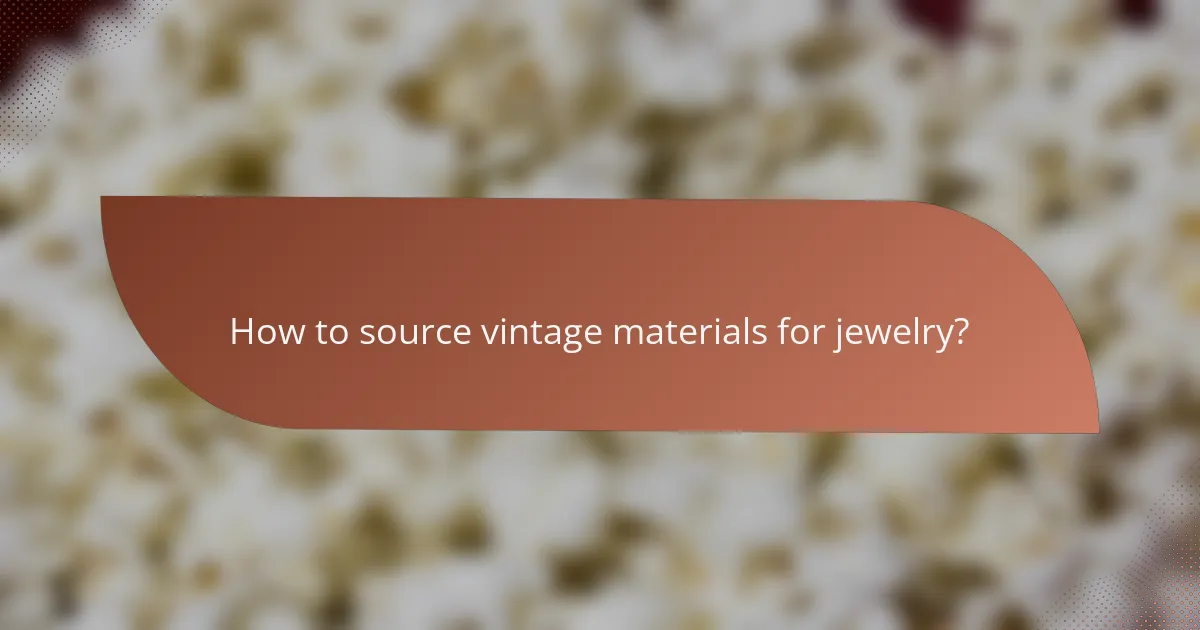
How to source vintage materials for jewelry?
Sourcing vintage materials for jewelry involves finding unique components that can enhance your designs. Look for items that reflect the aesthetic of the era you want to incorporate, ensuring they are suitable for crafting durable pieces.
Antique shops and flea markets
Antique shops and flea markets are treasure troves for vintage materials. These venues often feature a wide variety of items, from old buttons and clasps to intricate brooches that can be repurposed. When visiting, be prepared to spend time sifting through collections to find the perfect pieces.
Negotiating prices is common in these settings, so don’t hesitate to ask for discounts, especially if you’re purchasing multiple items. Always inspect materials for wear and tear to ensure they can withstand the rigors of jewelry making.
Estate sales and auctions
Estate sales and auctions can yield exceptional vintage finds, often at competitive prices. These events typically feature personal collections, which may include unique jewelry components or entire pieces that can be disassembled. Arrive early to get the best selection, and familiarize yourself with bidding processes if attending an auction.
Keep an eye out for items that have historical significance or unique craftsmanship, as these can add value to your jewelry. Be mindful of any potential restoration needs that could affect your budget and timeline.
Online marketplaces like Etsy
Online marketplaces like Etsy provide access to a global selection of vintage materials. You can find everything from vintage beads to antique findings, often with detailed descriptions and seller ratings. Use search filters to narrow down your options based on material type, era, or price range.
When purchasing online, check the seller’s return policy and shipping costs to avoid unexpected expenses. Consider reaching out to sellers for additional information or custom requests, as many are open to communication and can help you find exactly what you need.
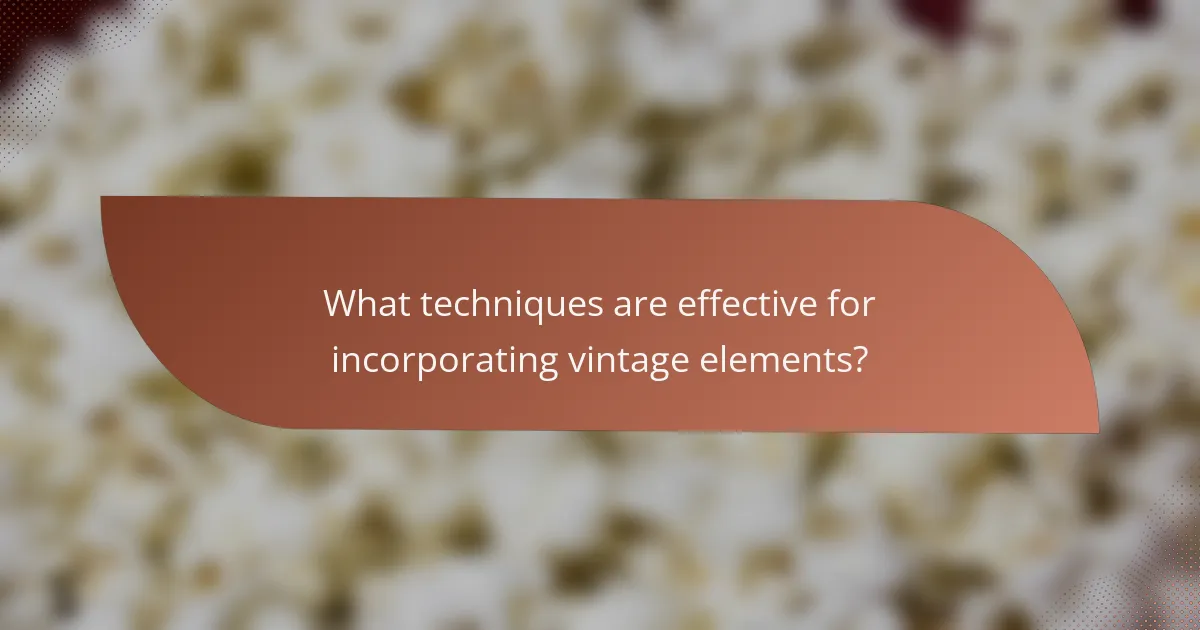
What techniques are effective for incorporating vintage elements?
Effective techniques for incorporating vintage elements into modern artisan jewelry include repurposing vintage findings, mixing modern materials with vintage designs, and using vintage-inspired patterns. These methods allow artisans to blend the charm of the past with contemporary aesthetics, creating unique pieces that resonate with a wide audience.
Repurposing vintage findings
Repurposing vintage findings involves taking old jewelry components, such as clasps, chains, or stones, and integrating them into new designs. This technique not only adds character but also promotes sustainability by giving new life to discarded items. Look for vintage pieces at estate sales or flea markets, where you can often find unique elements at reasonable prices.
When repurposing, ensure that the findings are in good condition and compatible with your modern materials. A common pitfall is overlooking the structural integrity of vintage components, which may require reinforcement or careful handling during assembly.
Mixing modern materials with vintage designs
Mixing modern materials, such as resin, acrylic, or stainless steel, with vintage designs can create striking contrasts that appeal to contemporary tastes. For instance, pairing a vintage brooch with a sleek, modern chain can highlight the intricacies of the vintage piece while maintaining a fresh look. Consider using materials that complement the vintage elements without overpowering them.
Be mindful of color and texture when combining these materials. A harmonious balance can enhance the overall aesthetic, while clashing materials may detract from the vintage charm. Experiment with different combinations to find what resonates best with your style.
Using vintage-inspired patterns
Using vintage-inspired patterns in your jewelry design can evoke a sense of nostalgia while appealing to modern sensibilities. Patterns such as Art Deco geometric shapes or Victorian floral motifs can be incorporated into metalwork or enamel designs. Look for inspiration in vintage textiles or wallpaper to create unique patterns that can be translated into jewelry.
When designing with vintage patterns, consider the scale and repetition of the motifs. Larger patterns may work well on statement pieces, while smaller, intricate designs can enhance more delicate items. Always aim for a cohesive look that reflects both the vintage inspiration and your personal style.
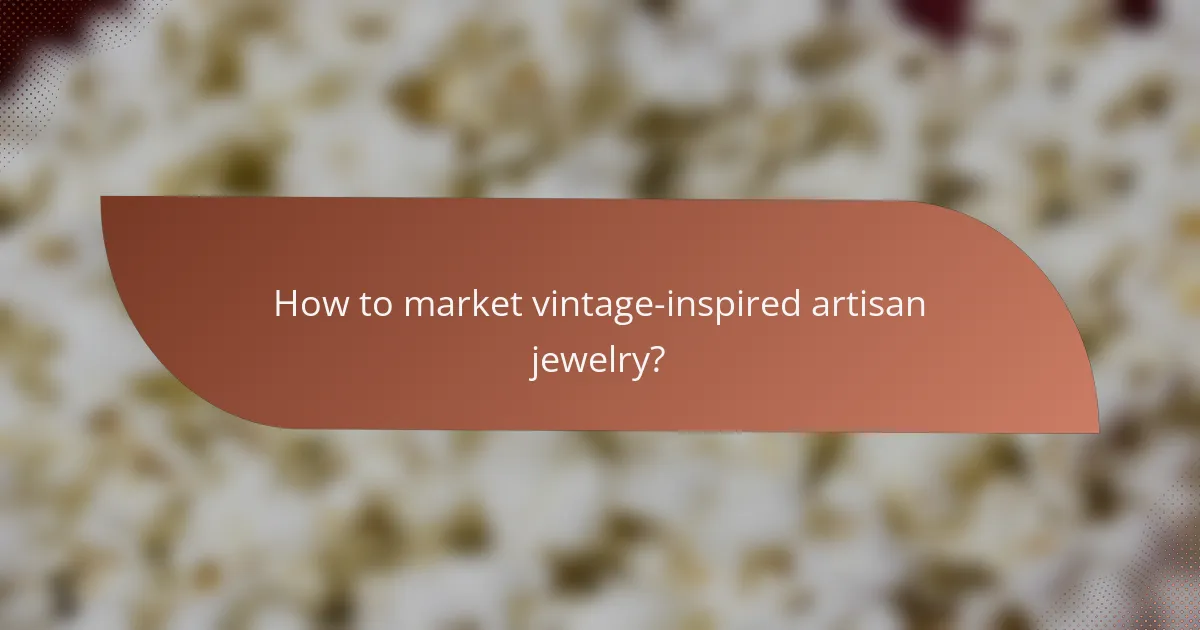
How to market vintage-inspired artisan jewelry?
Marketing vintage-inspired artisan jewelry involves showcasing its unique characteristics and connecting with an audience that appreciates its historical context. Focus on storytelling, leveraging social media, and collaborating with influencers to effectively reach potential customers.
Highlighting unique design stories
Each piece of vintage-inspired jewelry often has a story that reflects its design inspiration, whether it’s a specific era or a particular artisan technique. Share these narratives through product descriptions, blog posts, or social media captions to engage customers emotionally.
Consider creating content that explains the history behind certain styles, such as Art Deco or Victorian influences. This not only educates your audience but also enhances the perceived value of your jewelry.
Utilizing social media platforms
Social media is a powerful tool for marketing vintage-inspired artisan jewelry. Platforms like Instagram and Pinterest are particularly effective for visually showcasing your pieces and their unique designs. Use high-quality images and engaging captions to attract attention.
Engage with your audience by posting behind-the-scenes content, such as the design process or materials used. Regularly update your followers with new collections or limited editions to maintain interest and excitement.
Collaborating with vintage fashion influencers
Partnering with vintage fashion influencers can significantly boost your visibility and credibility in the market. Look for influencers who align with your brand values and have a genuine appreciation for vintage aesthetics.
Consider sending them pieces to wear and promote on their platforms. Their authentic endorsement can introduce your jewelry to a wider audience, making it more appealing to potential customers who trust their recommendations.
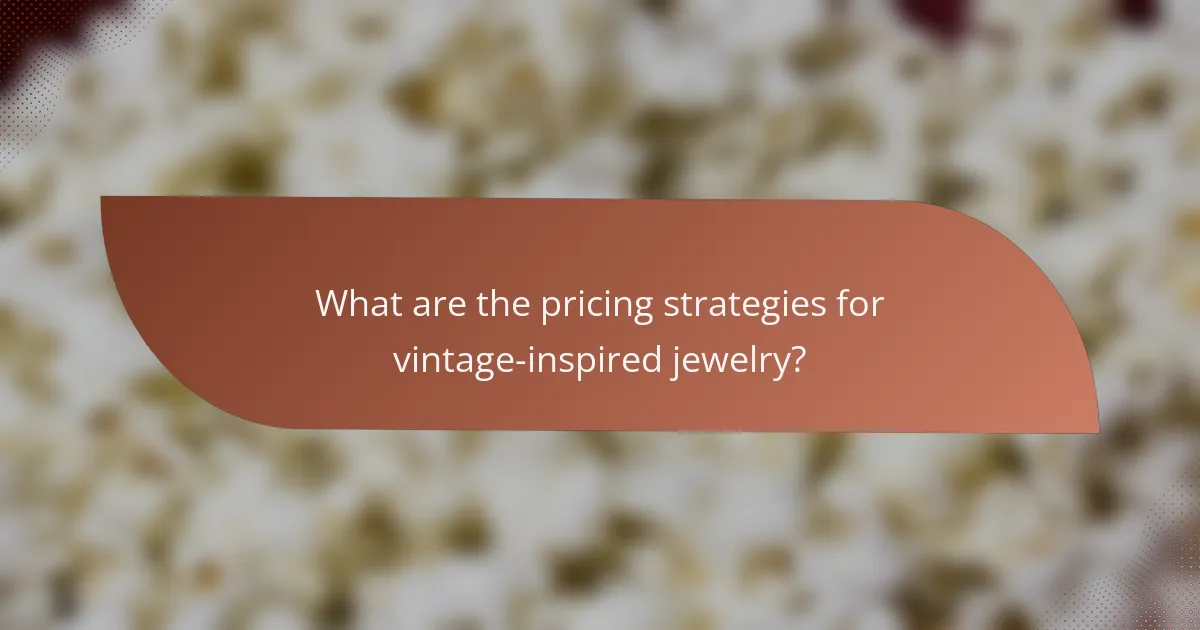
What are the pricing strategies for vintage-inspired jewelry?
Pricing strategies for vintage-inspired jewelry often involve a blend of cost-based and value-based pricing. Artisans should consider material costs, labor, and the perceived value of vintage aesthetics when setting prices.
Cost-Based Pricing
Cost-based pricing involves calculating the total cost of materials and labor, then adding a markup to ensure profitability. For vintage-inspired jewelry, artisans should account for unique materials, such as antique beads or reclaimed metals, which may increase costs significantly.
When determining the markup, consider industry standards, which typically range from 50% to 100% above the total cost. This approach ensures that all expenses are covered while allowing for a reasonable profit margin.
Value-Based Pricing
Value-based pricing focuses on the perceived value of the jewelry to the customer rather than just the cost. Artisans should assess how much customers are willing to pay for the vintage design and craftsmanship. This can be influenced by factors such as uniqueness, brand reputation, and market trends.
To implement value-based pricing, conduct market research to understand customer preferences and price points. This strategy may allow for higher prices, especially if the jewelry has a strong emotional or aesthetic appeal.
Competitive Pricing
Competitive pricing involves setting prices based on what similar vintage-inspired jewelry is selling for in the market. Research competitors’ pricing to ensure your products are positioned effectively within the market landscape.
Consider creating a pricing table comparing your jewelry with competitors. Highlight unique features or craftsmanship that justify a higher price if applicable. This strategy helps maintain competitiveness while emphasizing the value of your offerings.
Psychological Pricing
Psychological pricing leverages pricing strategies that appeal to customers’ emotions and perceptions. For example, pricing items at $49.99 instead of $50 can make a product seem more affordable and attractive.
Additionally, consider offering tiered pricing for different collections or limited editions. This can create a sense of exclusivity and urgency, encouraging customers to purchase before items sell out.
